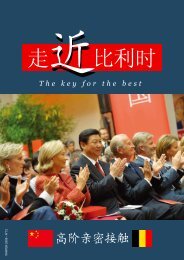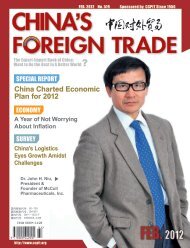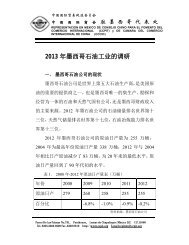Create successful ePaper yourself
Turn your PDF publications into a flip-book with our unique Google optimized e-Paper software.
the current earnings of a firm rise. The<br />
firm may use this additional income<br />
to fund the sunk costs of entering new<br />
markets. But once these investments are<br />
made, it will be very difficult, and most<br />
of the time impossible, to back out and<br />
recover the cost of those investments<br />
even in the case of an abrupt subsequent<br />
currency appreciation. If firms are credit<br />
constrained, they will face additional<br />
difficulties to fund new investments,<br />
and will be even more reluctant to take<br />
the chance of engaging in exports to<br />
markets characterised by highly volatile<br />
exchange rates.<br />
Lessons from China<br />
In our recent paper, we find support<br />
for this kind of mechanism using<br />
a panel of Chinese firms. In this study,<br />
we investigate both the impact of real<br />
exchange-rate volatility on the exporting<br />
behaviour and the way financial<br />
constraints, together with financial<br />
development, shape this relationship at<br />
the firm level. Our empirical estimations<br />
rely on export data for more than<br />
100,000 Chinese exporters over the<br />
period 2000-06. We have access to<br />
information on firms’ foreign sales as<br />
well as on the structure of their exports,<br />
including the products and destinations<br />
they serve. We also infer firm-level financial<br />
vulnerability from the financial<br />
dependence of their activities. Using<br />
this detailed information, we identify<br />
the impact of exchange-rate volatility<br />
(defined as the yearly standard deviation<br />
of monthly log differences in the real<br />
exchange rate, the latter being computed<br />
as the ratio of nominal exchange rate<br />
of the yuan with respect to the partner’s<br />
currency divided by the partner’s price<br />
level) on different measures of intensive<br />
and extensive margins, depending on<br />
the level of financial constraints.<br />
We find that that firms tend to<br />
export less and fewer products to destinations<br />
with higher exchange-rate<br />
volatility. It also appears that the magnitude<br />
of this export-deterring effect<br />
depends on the extent of firms’ financial<br />
vulnerability. To illustrate these results,<br />
we can compare the reduction in the<br />
export performance due to real-exchange-rate<br />
volatility for strongly and<br />
weakly credit-constrained firms. Regarding<br />
the strongly constrained firms,<br />
our results suggest that a two percentage<br />
point (i.e. one standard deviation)<br />
increase in yearly real-exchange-rate<br />
volatility would reduce the export value<br />
by 3%, and the number of exported<br />
products by 0.85%. The effect is lower,<br />
but still present, for weakly constrained<br />
firms: for them, the same 2% increase<br />
in yearly real-exchange-rate volatility<br />
cuts the export value by 0.24%, and the<br />
number of exported products by 0.07%.<br />
Tough non-negligible, the effects appear<br />
therefore quantitatively less important<br />
for the extensive margin of trade than<br />
for the intensive margin.<br />
Mitigating role of financial<br />
development<br />
We subsequently exploit Chinese<br />
cross-provincial heterogeneity to study<br />
how financial development (measured as<br />
the share of total credit over GDP in the<br />
province) may mitigate both credit constraints<br />
and exchange-rate volatility. We<br />
do find that financial development directly<br />
(that is, independently of the level<br />
of financial dependence) dampens the<br />
negative impact of real-exchange-rate<br />
volatility, but our results also point to<br />
an even stronger relaxation effect when<br />
sectoral financial dependence increases,<br />
especially on the intensive margin of export.<br />
Quantitatively, this second type of<br />
effect is much stronger than the direct<br />
one, with a range from one to ten.<br />
These results are directly in line<br />
with recent macroeconomic literature<br />
emphasising that financial development<br />
tends to reduce the impact of exchangerate<br />
volatility on economic performance.<br />
Doing so, we provide a microfounded<br />
investigation of this effect, and propose<br />
a potential channel for it (through exports).<br />
Policy implications<br />
Our results emphasise that the<br />
magnitude of the negative impact of<br />
real-exchange-rate volatility depends<br />
mainly on the extent of financial<br />
constraints, and therefore, on the level<br />
of financial development. These findings<br />
in the Chinese context are especially<br />
interesting, because China appears as a<br />
typical case for analysing issues raised<br />
by exchange-rate volatility for developing<br />
countries. First, as the country is<br />
progressively giving up its relatively rigid<br />
exchange-rate system, the exchange-rate<br />
volatility is expected to substantially rise<br />
in the future, due to progressive removal<br />
of trading restrictions on the yuan, with<br />
a goal of having a basically convertible<br />
currency by 2015. Second, the export<br />
rate is particularly high related to the<br />
economic size of China, leading to substantial<br />
exposure to exchange-rate fluctuations.<br />
Finally, the high heterogeneity<br />
in terms of both (regional) financial<br />
development and (sectoral) financial<br />
dependence enlightens that credit constraints<br />
are key in determining to what<br />
extent the exchange-rate volatility will<br />
be harmful to trade.<br />
General lessons<br />
There are a couple of lessons to<br />
draw from our research:<br />
The development of credit markets<br />
is crucial to help firms to overcome the<br />
additional export sunk cost related to<br />
real-exchange-rate volatility.<br />
Better access to external finance<br />
would support the expansion of firms’<br />
exports, particularly to those destinations<br />
characterised by real-exchange<br />
rate-related uncertainty.<br />
More generally, our study emphasises<br />
that emerging countries should be<br />
careful when relaxing their exchangerate<br />
regime.<br />
Hard fixed pegs for developing<br />
countries are certainly not always a<br />
panacea, but moving to a fully floating<br />
regime without the adequate level of<br />
financial development could also prove<br />
to be very hazardous for trade performance.<br />
(VoxEU)<br />
(Authors: Jérôme Héricourt,<br />
Assistant Professor at EQUIPPE,<br />
University of Lille; Sandra Poncet,<br />
Professor at the University of Paris I<br />
and scientific advisor at CEPII)<br />
27

















